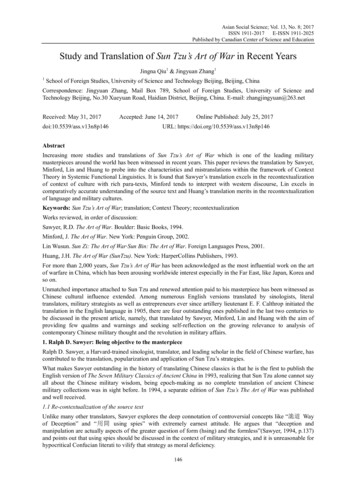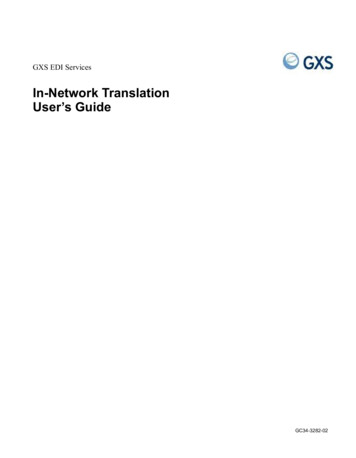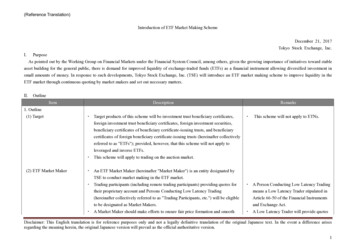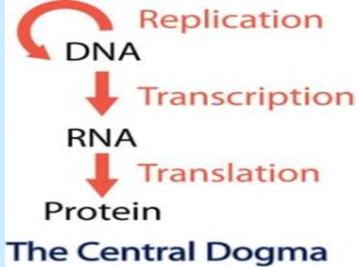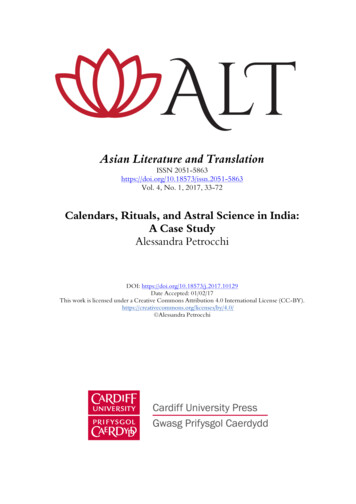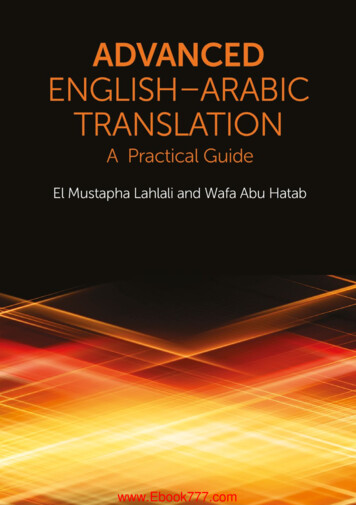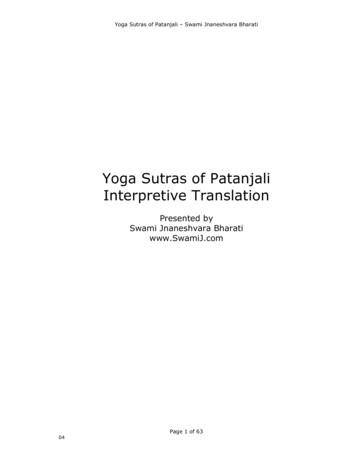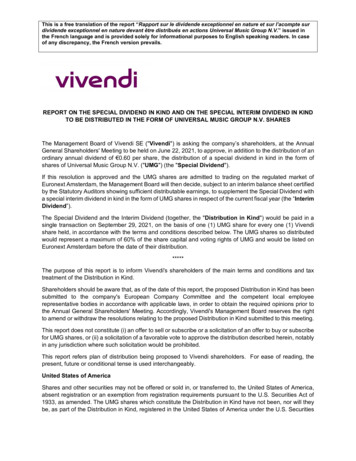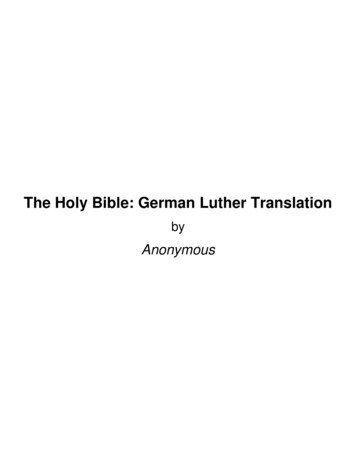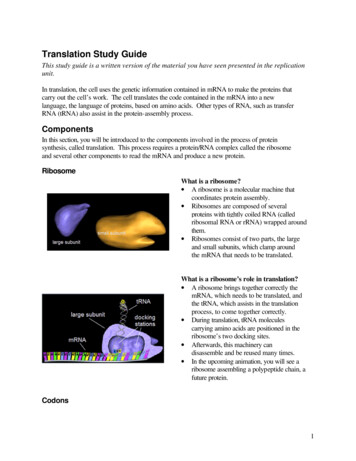
Transcription
Translation Study GuideThis study guide is a written version of the material you have seen presented in the replicationunit.In translation, the cell uses the genetic information contained in mRNA to make the proteins thatcarry out the cell’s work. The cell translates the code contained in the mRNA into a newlanguage, the language of proteins, based on amino acids. Other types of RNA, such as transferRNA (tRNA) also assist in the protein-assembly process.ComponentsIn this section, you will be introduced to the components involved in the process of proteinsynthesis, called translation. This process requires a protein/RNA complex called the ribosomeand several other components to read the mRNA and produce a new protein.RibosomeWhat is a ribosome? A ribosome is a molecular machine thatcoordinates protein assembly. Ribosomes are composed of severalproteins with tightly coiled RNA (calledribosomal RNA or rRNA) wrapped aroundthem. Ribosomes consist of two parts, the largeand small subunits, which clamp aroundthe mRNA that needs to be translated.What is a ribosome’s role in translation? A ribosome brings together correctly themRNA, which needs to be translated, andthe tRNA, which assists in the translationprocess, to come together correctly. During translation, tRNA moleculescarrying amino acids are positioned in theribosome’s two docking sites. Afterwards, this machinery candisassemble and be reused many times. In the upcoming animation, you will see aribosome assembling a polypeptide chain, afuture protein.Codons1
What is a codon? A codon is a sequence of three nucleotides on an mRNA strand that encodes a specific aminoacid. The mRNA sequence, in turn, is derived from the cell’s DNA.Which codons correspond to which amino acids? This chart shows the correspondence between codons and amino acids. This code has been deciphered. By knowing a DNA sequence, it is possible to determine thesequence of amino acids in the polypeptide chain for which the DNA codes. Sixty-four different three nucleotide combinations (codons) can be made using the fournucleotides in mRNA (43 64 combinations). Three codons are called stop codons, which tell the cell to stop translating the mRNA and donot encode an amino acid. The code is redundant. For most amino acids, multiple codons exist, each of which couldcode for that amino acid.2
Transfer RNA (tRNA)What is tRNA? tRNA is a type of RNA that is folded into a specificthree-dimensional structure. It carries and transfers anamino acid to the polypeptide chain that the ribosomeis assembling. One end of the tRNA contains an anticodon, asequence of three nucleotides that is complementary tothe three nucleotides in the corresponding codon onthe mRNA. Each anticodon is specific to one and onlyone codon. By binding its anticodon to the complementary mRNAcodon, the tRNA acts as an adapter, bringing intoposition the correct amino acid that is needed for thepolypeptide chain. Each cell makes 61 different tRNAs, one for eachfunctional codon in the genetic code.How does tRNA bind to codons in the mRNA? The complementary bases on the codon and anticodon are held together by hydrogen bonds,the same type of bonds that hold together the nucleotides in DNA. The ribosome only allows the tRNA to bind to the mRNA if it is carrying an amino acid.Once the amino acid is added to the polypeptide chain, the binding is no longer favored.How does the code in DNA get converted into a specific amino acid sequence in thepolypeptide? Nucleotides in the DNA specify the nucleotides in the mRNA. Nucleotides in the mRNA are read 3 at a time (as codons) by the ribosome. Each codon specifies a particular amino acid in the growing polypeptide chain. That codon matches only the anticodon of the tRNA carrying the particular amino acidspecified by the codon. The ribosome facilitates the binding of the tRNA to the codon. The tRNA carries the correctamino acid, which is added to the polypeptide chain in the correct position. In the animation for this unit, you will see tRNA carrying and transferring amino acids toassemble a polypeptide chain.3
Process Flow ChartAnimation scriptIn translation, the cell uses an mRNA strand that it has just transcribed from its genetic code as atemplate to assemble proteins. The cell has just transcribed this mRNA strand from its DNA,and it now translates the mRNA’s nucleotide sequence into a chain of amino acids. This chain,called a polypeptide, forms the basic structure of a protein.A cellular component called a ribosome coordinates the translation process. A ribosome is amolecular machine that synthesizes proteins in the cell. It consists of two main parts, a large andsmall subunit.4
The ribosome brings together the mRNA to betranslated and a set of molecules called transferRNAs, or tRNAs, which are floating in thecell. tRNAs are adapter molecules thatcoordinate between the mRNA and thepolypeptide chain that the cell needs to build.Each tRNA is designed to carry a specificamino acid that it can add to a polypeptidechain.tRNAs bring their amino acids to the mRNA ina specific order. This order is determined bythe attraction between a codon, a sequence ofthree nucleotides on the mRNA, and acomplementary nucleotide triplet on the tRNA,called an anticodon. This anticodon alsospecifies the particular amino acid that thetRNA carries. Only the tRNA carrying thenext amino acid in the polypeptide chain hasthe anticodon that binds to the appropriatelocation on the mRNA. This system ensuresthat amino acids are added to the chain in thecorrect order.At the beginning of translation, the ribosomeand a tRNA attach to the mRNA. The tRNA islocated in the ribosome’s first docking site.5
This tRNA's anticodon is complementary tothe mRNA’s initiation codon, wheretranslation starts.The tRNA carries the amino acid that corresponds to that codon.The next mRNA codon is now exposed in theribosome's other docking site. A tRNA withthe complementary anticodon is attracted to theribosome and binds to this codon. The tRNAcarries the next amino acid in the polypeptidechain.The first tRNA transfers its amino acid to theamino acid on the newly arrived tRNA, and achemical bond is made between the two aminoacids.The tRNA that has given up its amino acid is released. It can then bind to another molecule ofthe amino acid and be used again later in the protein-making process.6
Using a ratcheting mechanism, the ribosomeadvances the mRNA, three nucleotides at atime. The ribosome also shifts the tRNAcarrying the polypeptide chain into its recentlyvacated docking site.A tRNA whose anticodon is complementary tothis next mRNA codon is attracted to theribosome and the mRNA.Once again, the polypeptide chain is transferred to the new tRNA, the empty tRNA is released,and the ribosome ratchets through the mRNA another three nucleotides, simultaneously shiftingthe tRNA as well. As this process continues, the polypeptide chain grows longer.Translation continues until the ribosomeencounters a stop codon in the mRNA. Thisnucleotide triplet signals that the polypeptidechain is complete.7
The stop codon causes all the components oftranslation to separate. The ribosome candisassemble and be used again. The mRNA isdiscarded by being degraded back into itsbuilding blocks, the nucleotides. New mRNAcan be synthesized via transcription when moreof that protein is needed.The cell has now successfully translated one of its genes into a polypeptide chain, the rawmaterial of a protein. This chain will be further processed and folded into a protein. Everyprotein-encoding gene in the cell is transcribed and translated in this manner so that the cell cancreate the thousands of proteins that it needs to carry out all of its essential functions.Translation, then, is one stage in the process inwhich the cell’s genetic information is used tocreate proteins. The cell’s DNA is firsttranscribed in a temporary copy (mRNA),which is then translated into the amino acidsequence of a protein.Glossary of termsamino acids – twenty molecules that are the building blocks of proteins. String of amino acidsmake up protein’s primary structure.anticodon – a sequence of three nucleotides on a tRNA molecule that bond to a complementarysequence on an mRNA molecule. The anticodon sequence determines the amino acid that thetRNA carries.codon – a sequence of three nucleotides on a mRNA molecule that encode a specific amino acidcomplementary - matching, such as between pairs of nucleotides in a DNA moleculeDNA - the molecule that stores and encodes an organism’s genetic information. DNA is adouble helix molecule made up of two twisted strands that are held together by hydrogen bondsbetween paired nucleotides. The two strands are chemically oriented in opposite directions.enzyme - a type of protein that performs cellular activitieshydrogen bond - a weak bond that holds together complementary base pairs in a DNA molecule8
messenger RNA (mRNA) – a type of RNA that conveys genetic instructions on how toassemble proteins from the cell’s DNA to its protein-making machinery. mRNA contains a copyof one or a few genes from a cell’s chromosome.nucleotides - the building blocks of DNA and RNA molecules that contain the cell’s geneticcode. Adenosine, cytidine, guanosine, thymidine, and uridine are all nucleotides.polypeptide chain – the long chain of amino acids that is created during translation. Apolypeptide chain becomes a protein when it folds into its final functional shape.protein - a molecular machine that carries out vital tasks in the cell, such as providing structuralsupport, processing nutrients, copying a cell’s DNA, and regulating other cellular functions.Proteins are made of long chains of amino acids that fold into complex three-dimensional shapes.Each type protein has a unique amino acid sequence and a specific function in the cell.replication – the process in which a cell’s DNA is copied prior to cellular reproductionribosomal RNA (rRNA) – a type of RNA that assists in the protein-making process. rRNA isfound in the cell’s ribosomes.ribosome – a molecular machine that coordinates protein assembly. A ribosome consists of twoparts, a large and small subunit, which clamp around an mRNA molecule that needs to betranslated. A ribosome is composed of several proteins with tightly coiled rRNA wrappedaround them.RNA – a polymer made of a single strand of nucleotides. RNA contains the same nucleotides asDNA, with the substitution of uridine for thymidine.stop codon – a three-nucleotide sequence that signals the cell to end protein synthesis duringtranslationtranscription – the process in which a cell’s DNA is copied into messenger RNA, which is thenread by the cell’s protein-making machinery. Transcription is a major step in the transfer ofinformation in biology. Transcribe is the verb associated with transcription.transfer RNA (tRNA) – a type of RNA that is folded into a three-dimensional structure. tRNAcarries and transfers an amino acid to the polypeptide chain being assembled during translation.translation – the process in which a cell converts genetic information carried in an mRNAmolecule into a protein. Translation is a major step in the transfer of information in biology. Inthis case, translate is the verb associated with translation.9
Once the amino acid is added to the polypeptide chain, the binding is no longer favored. How does the code in DNA get converted into a specific amino acid sequence in the polypeptide? Nucleotides in the DNA specify the nucleotides in the mRNA. Nucleotides in the mRNA are read

